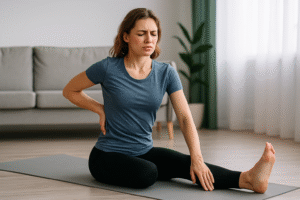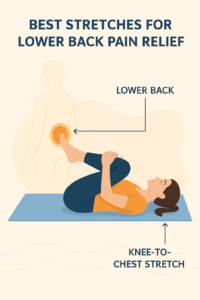Best Stretches for Lower Back Pain Relief

When dealing with discomfort, practicing the best stretches for lower back pain relief is essential for long-term wellness. Lower back pain affects millions of people worldwide. It can range from a dull ache to debilitating discomfort, impacting daily activities and overall quality of life. Before diving into the best stretches for lower back pain relief, it is crucial to understand what causes lower back pain, how it manifests, and why addressing it early is so important. In this article, we will first explore the fundamentals of lower back pain—its causes, symptoms, and risk factors—and then present a comprehensive guide to effective stretches that can provide relief and support recovery.
What Is Lower Back Pain?
Lower back pain refers to discomfort in the lumbar region of the spine, which supports much of the upper body’s weight. It can be acute, lasting a few days to weeks, or chronic, persisting for more than three months. The pain may be sharp, stabbing, or a constant dull ache, depending on its underlying cause. Incorporating the best stretches for lower back pain relief into your daily routine can significantly reduce discomfort and stiffness.
Common Causes of Lower Back Pain
- Muscle or Ligament Strain: Lifting heavy objects improperly or sudden awkward movements can strain muscles and ligaments.
- Disc Problems: Herniated or bulging discs can press on nerves, causing pain.
- Arthritis: Osteoarthritis can lead to lower back pain due to joint degeneration.
- Poor Posture: Sitting or standing incorrectly for extended periods puts stress on the lower back.
- Injuries: Falls, accidents, or sports injuries can cause trauma to the lower back.
- Structural Problems: Conditions like scoliosis, where the spine curves abnormally, may lead to pain.
Symptoms of Lower Back Pain
- Persistent aching or stiffness along the spine
- Sharp, localized pain after lifting heavy objects
- Chronic ache in the lower back after sitting for long periods
- Pain that radiates down the leg (sciatica)
- Difficulty standing up straight or moving normally
Risk Factors for Lower Back Pain
- Age: Risk increases with age, especially after 30-40 years.
- Lack of Exercise: Weak, unused muscles can lead to pain.
- Obesity: Excess body weight stresses the back.
- Occupational Hazards: Jobs that require heavy lifting, pushing, or pulling.
- Psychological Conditions: Depression and anxiety can influence perception of pain.
- Smoking: Reduces blood flow to the spine and increases risk of degenerative disc disease.
Why It’s Important to Address Lower Back Pain Early
Experts recommend including the best stretches for lower back pain relief as part of your daily routine. If left untreated, lower back pain can become chronic, leading to decreased mobility, muscle weakness, and even emotional distress. Early intervention with proper stretching and strengthening can significantly improve outcomes and prevent long-term damage.
Now Let’s Move to the Solution: Best Stretches for Lower Back Pain Relief
The following stretches are designed to relieve lower back pain, improve flexibility, and strengthen supporting muscles. Always perform these exercises gently and listen to your body. By regularly practicing the best stretches for lower back pain relief, you can enhance your posture and overall physical strength.
1. Child’s Pose
Benefits: Relieves tension in the lower back, hips, and thighs.
How to Perform:
- Kneel on the floor, sit back on your heels.
- Stretch your arms forward and lower your forehead to the ground.
- Hold for 30 seconds to 1 minute.
- Breathe deeply and relax.
Tip: Keep your knees wide apart for a deeper stretch.
2. Cat-Cow Stretch
Benefits: Improves flexibility and warms up the spine.
How to Perform:
- Start on your hands and knees in a tabletop position.
- Inhale, arch your back (Cow Pose).
- Exhale, round your spine (Cat Pose).
- Repeat for 1-2 minutes.
Tip: Move slowly and coordinate with your breath.
3. Supine Twist
Benefits: Stretches the lower back, spine, and hips.
How to Perform:
- Lie on your back with your arms extended out.
- Bend your knees and gently lower them to one side.
- Hold for 30 seconds, then switch sides.
Tip: Keep your shoulders flat on the floor.
4. Knee-to-Chest Stretch
Benefits: Loosens tight lower back muscles.
How to Perform:
- Lie flat on your back.
- Bring one knee toward your chest.
- Hold the stretch for 20-30 seconds.
- Switch legs and repeat.
Tip: Gently pull the knee without straining.

5. Seated Forward Bend
Benefits: Stretches the spine, hamstrings, and lower back.
How to Perform:
- Sit with your legs extended straight.
- Reach forward toward your toes.
- Hold for 30 seconds to 1 minute.
Tip: Keep your back straight to avoid straining.
6. Cobra Stretch
Benefits: Strengthens lower back muscles and relieves pressure.
How to Perform:
- Lie on your stomach.
- Place hands under shoulders and lift your chest.
- Hold the stretch for 15-30 seconds.
Tip: Keep hips on the floor and avoid overextending.
7. Piriformis Stretch
Benefits: Targets the piriformis muscle, which can contribute to lower back pain.
How to Perform:
- Lie on your back and cross one ankle over the opposite knee.
- Pull the uncrossed leg toward your chest.
- Hold for 20-30 seconds.
Tip: You should feel the stretch in your buttocks, not your lower back.
8. Happy Baby Pose
Benefits: Gently stretches the spine and relaxes the hips.
How to Perform:
- Lie on your back and grab the outside of your feet.
- Open your knees wider than your torso.
- Hold the pose for 30 seconds to 1 minute.
Tip: Gently rock side to side for a soothing massage effect.
9. Standing Hamstring Stretch
Benefits: Stretches the hamstrings and reduces lower back tension.
How to Perform:
- Stand tall, then bend forward at the hips.
- Let your arms hang down.
- Hold for 30 seconds.
Tip: Keep a slight bend in your knees to avoid straining your lower back.
10. Pelvic Tilt Stretch
Benefits: Strengthens and stabilizes the lower back and core muscles.
How to Perform:
- Lie on your back with knees bent.
- Tighten your abdominal muscles and press your back into the floor.
- Hold for 5-10 seconds.
- Repeat 10-15 times.
It is important to warm up your body before performing the best stretches for lower back pain relief to avoid injuries.
Tip: Perform slowly for best results.
Stretching Routine for Lower Back Pain Relief
Morning Routine (5-10 Minutes):
- Cat-Cow Stretch
- Child’s Pose
- Cobra Stretch
Midday Routine (5 Minutes):
- Standing Hamstring Stretch
- Seated Forward Bend
Evening Routine (10-15 Minutes):
- Supine Twist
- Knee-to-Chest Stretch
- Happy Baby Pose
Tips for Safe Stretching
- Warm Up First: Always warm up your muscles with light activity like walking.
- Move Slowly: Avoid jerky movements.
- Breathe Deeply: Deep breathing enhances relaxation.
- Listen to Your Body: Never push into sharp pain.
- Stay Consistent: Aim to stretch daily for the best results.
When to See a Doctor
While stretching can be highly beneficial, consult a doctor if you experience:
-
- Severe pain that doesn’t improve
- Numbness or tingling
- Weakness in your legs
- Loss of bladder or bowel control
Remember, consistency is key when doing the best stretches for lower back pain relief to achieve noticeable improvements.
Conclusion
Lower back pain can be debilitating, but incorporating simple stretches into your daily routine can offer tremendous relief. The stretches outlined here are easy to perform at home and can help improve your flexibility, posture, and overall spine health. Remember to move mindfully, stay consistent, and consult a healthcare provider if necessary. Start stretching today and take the first step towards a healthier, pain-free back!
FAQs
Q: How often should I stretch to relieve lower back pain?
A: Ideally, you should stretch daily to maintain flexibility and support lower back health.
Q: How long should I hold each stretch?
A: Aim to hold each stretch for 20-30 seconds, and repeat if necessary.
Q: Can stretching prevent future lower back pain?
A: Yes, regular stretching strengthens muscles and improves posture, which can help prevent future pain.
Q: Is it normal to feel sore after stretching?
A: Mild soreness is normal, but sharp pain is a warning sign to stop.
Q: Should I stretch if I have a herniated disc?
A: Consult a healthcare professional before attempting stretches if you have a herniated disc or other serious spinal conditions.
Stay Connected with Treat Your Day
Thank you for spending your time with us! We hope this guide has helped you better understand how to care for your lower back and improve your well-being.
If you enjoyed this article and want to keep learning more about health, wellness, and everyday tips, make sure to stay in touch. Scroll down to subscribe to our free newsletter and receive our latest updates straight to your inbox!
We’d also love to hear your thoughts! If you have any questions, feedback, or personal stories, feel free to leave us a message. Together, we can build a stronger and healthier community!
More Ways to Stay Connected:
- Discover more: What Happens to Your Brain When You Sleep
- Support and inspire: Visit DailyDoseStories.com
Let’s continue this journey toward better health together!

